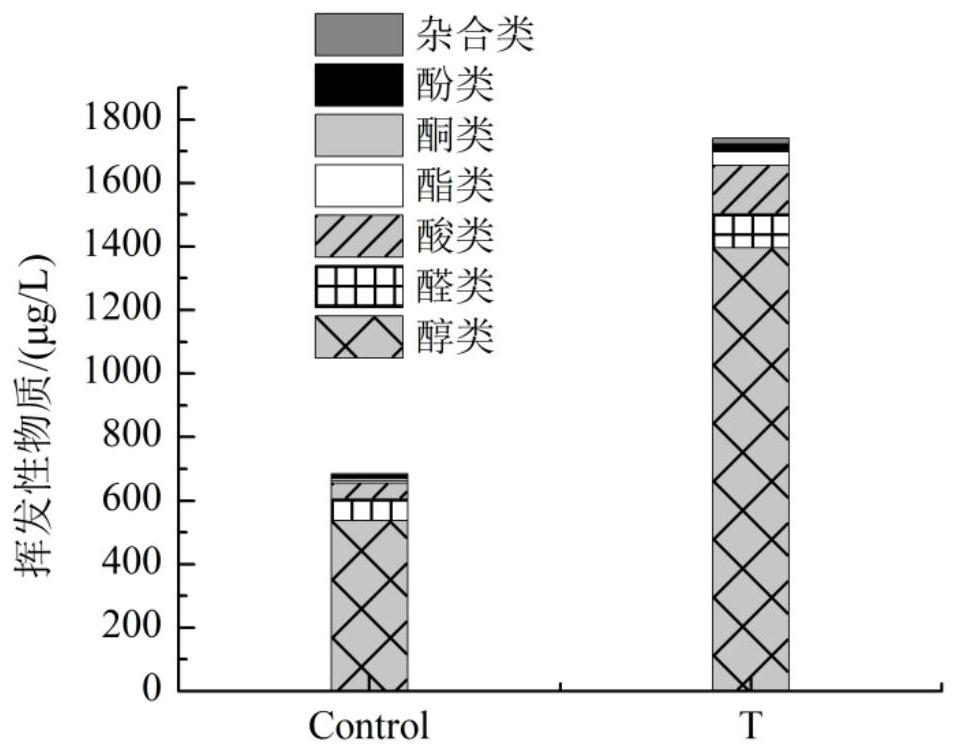A strain of Tetracoccus halophilus and its application in soy sauce production
A technology of halophilic tetradococcus and soy sauce, which is applied in the direction of microorganism-based methods, bacteria, microorganisms, etc., can solve the problems of low content, few types, and weak ability to increase the flavor of soy sauce, so as to achieve a good aroma-enhancing effect and enhance the flavor Effect
- Summary
- Abstract
- Description
- Claims
- Application Information
AI Technical Summary
Problems solved by technology
Method used
Image
Examples
Embodiment 1
[0026] Example 1: Enhancing soy sauce fermentation with Tetracoccus halophilus R44
[0027] (1) strain culture
[0028] Cultivation of Tetraphylococcus halophila R44: Take out the preserved Tetraphylococcus halophila R44 from the -80°C refrigerator, inoculate it into MRS medium, stand at 30°C for 60h, and transfer it to a 1% volume of inoculum. In fresh MRS medium, stand at 30°C to OD 600 to 1.2.
[0029] (2) Soy sauce fermentation process
[0030] Koji-making process: soak the soybean meal with 1.2 times the mass of water for 2 hours, sterilize it at 121°C for 15 minutes, and cool it to room temperature; add 1.5‰ mass ratio of Aspergillus oryzae spores according to the dry weight of raw materials (total weight after mixing soybean meal and wheat particles). First, mix the spore powder with an appropriate amount of fried wheat granules evenly, and then fully mix with soybean meal and wheat granules (the mass ratio of soybean meal and wheat granules is 6:4); culture in a bio...
Embodiment 2
[0033] Example 2: Determination of the number of Tetracoccus halophilus R44
[0034] In order to confirm that the addition of strains can enhance the effect of Tetraphylococcus halophila R44 in the fermentation process of soy sauce, the number of Tetraphylococcus halophila R44 was determined by plate counting method. Weigh 1g of the mash, pour it into a conical flask containing sterilized glass beads and 99mL of normal saline, and mix it well, and then dilute it gradiently (diluted to 10 -2 , 10 -3 , 10 -4 , 10 -5 , 10 -6 , 10 -7 ), diluted and applied to MRS (containing 0.1 g·L -1 Natamycin, 100g L -1 NaCl) plate, and counted after 4-6d incubation at 30°C. Tetraphylococcus halophila R44 is a facultative anaerobic bacterium with long plate culture cycle and small colony size.
[0035] The results showed that the addition of Tetraphylococcus halophila R44 could increase the number of these bacteria in the mash by 1.9-3.0 orders of magnitude compared with the control wit...
Embodiment 3
[0036] Example 3: The effect of Tetracoccus halophilus R44 on the total acid content of soy sauce
[0037] Samples were taken on days 15, 20, 25, 30, 35, 40, 45, 60 and 75. Take 100g of soy mash respectively in a centrifuge tube, 12000r·min -1After centrifugation for 30 min, the supernatant was taken and filtered through a filter membrane with a pore size of 0.22 μm for physical and chemical index determination. The determination of the total acid content of the sauce mash adopts the acidity meter method (refer to the specific steps). H, Tekin A, Musa M. Determination of fatty acid, tocopherol and phytosterol contents of the oils of various poppy (Papaver somniferum L.) seeds. [J]. Grasas Y Aceites. 2009, 60(4):375-381.).
[0038] It was found that adding Tetraphylococcus halophila R44 could increase the total acid content in soy sauce by 10.4%.
[0039] Table 1 Total acid content in soy sauce samples at different times (g / kg)
[0040]
[0041] Note: Control is the f...
PUM
| Property | Measurement | Unit |
|---|---|---|
| pore size | aaaaa | aaaaa |
Abstract
Description
Claims
Application Information
 Login to View More
Login to View More - R&D
- Intellectual Property
- Life Sciences
- Materials
- Tech Scout
- Unparalleled Data Quality
- Higher Quality Content
- 60% Fewer Hallucinations
Browse by: Latest US Patents, China's latest patents, Technical Efficacy Thesaurus, Application Domain, Technology Topic, Popular Technical Reports.
© 2025 PatSnap. All rights reserved.Legal|Privacy policy|Modern Slavery Act Transparency Statement|Sitemap|About US| Contact US: help@patsnap.com



